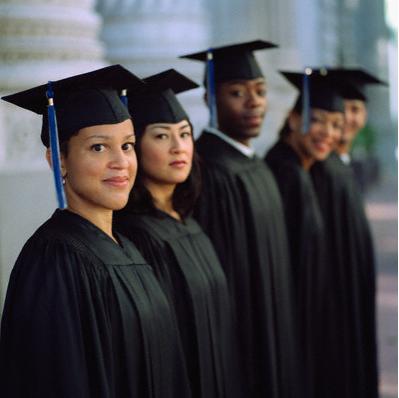More Women Than Men Earned Doctorate Degrees in US Last Year
 For the first time, more women than men in the United States received doctoral degrees last year, the culmination of decades of change in the status of women at colleges nationwide.
For the first time, more women than men in the United States received doctoral degrees last year, the culmination of decades of change in the status of women at colleges nationwide.The number of women at every level of academia has been rising for decades. Women now hold a nearly 3-to-2 majority in undergraduate and graduate education. Doctoral study was the last holdout - the only remaining area of higher education that still had an enduring male majority.
Of the doctoral degrees awarded in the 2008-09 academic year, 28,962 went to women and 28,469 to men, according to an annual enrollment report from the Council of Graduate Schools, based in Washington.
Doctoral degrees, which require an average of seven years' study, are typically the last to show the impact of long-term changes. "It is a trend that has been snaking its way through the educational pipeline," said Nathan Bell, the report's author and the director of research and policy analysis for the council. "It was bound to happen."
Women have long outnumbered men in earning master's degrees, especially in education. Women earned nearly six in 10 graduate degrees in 2008-09, according to the new report, which is based on an annual survey of graduate institutions.
But women who aspired to become college professors, a common path for those with doctorates, were hindered by the particular demands of faculty life. Studies have found that the tenure clock often collides with the biological clock: The busiest years of the academic career are the years that well-educated women tend to have children.
"Many women feel they have to choose between having a career in academics and having a family," said Catherine Hill, director of research at the American Association of University Women. "Of course, they shouldn't have to."
Undergraduate women began reaching parity with men in the early 1980s as societal barriers to female scholarship fell away. And then they eclipsed men - so thoroughly that federal officials are now investigating whether some liberal arts schools are favoring men in admissions to preserve some semblance of gender balance.
A freshman seminar at the University of Iowa called "Graduate School: Is It for You?" drew 16 students last year, Associate Provost John Keller said. Fifteen of them were women.
Scholarly attention in recent years has turned to the fallen aspirations of men, who are more likely than women to drop out of high school and more apt to be diverted from higher education into menial labor or prison. Men also join the military in disproportionate numbers.
Overall, women and girls make up 51 percent of the U.S. population. But women have not conquered every corridor of the ivory tower. Men still hold the majority of faculty and administration positions. Women earn less than men at every level of academic rank, according to the American Association of University Professors. Male faculty members earned $87,206 on average and their female counterparts made $70,600 in the 2009-10 academic year. Starting salaries for newly minted faculty members are nearly equal.
Click here to read the full story:
By Daniel de Vise
The Washington Post
Related links:
More About Women In Leadership On AWR
But women who aspired to become college professors, a common path for those with doctorates, were hindered by the particular demands of faculty life. Studies have found that the tenure clock often collides with the biological clock: The busiest years of the academic career are the years that well-educated women tend to have children.
"Many women feel they have to choose between having a career in academics and having a family," said Catherine Hill, director of research at the American Association of University Women. "Of course, they shouldn't have to."
Undergraduate women began reaching parity with men in the early 1980s as societal barriers to female scholarship fell away. And then they eclipsed men - so thoroughly that federal officials are now investigating whether some liberal arts schools are favoring men in admissions to preserve some semblance of gender balance.
A freshman seminar at the University of Iowa called "Graduate School: Is It for You?" drew 16 students last year, Associate Provost John Keller said. Fifteen of them were women.
Scholarly attention in recent years has turned to the fallen aspirations of men, who are more likely than women to drop out of high school and more apt to be diverted from higher education into menial labor or prison. Men also join the military in disproportionate numbers.
Overall, women and girls make up 51 percent of the U.S. population. But women have not conquered every corridor of the ivory tower. Men still hold the majority of faculty and administration positions. Women earn less than men at every level of academic rank, according to the American Association of University Professors. Male faculty members earned $87,206 on average and their female counterparts made $70,600 in the 2009-10 academic year. Starting salaries for newly minted faculty members are nearly equal.
Click here to read the full story:
By Daniel de Vise
The Washington Post
Related links:
More About Women In Leadership On AWR